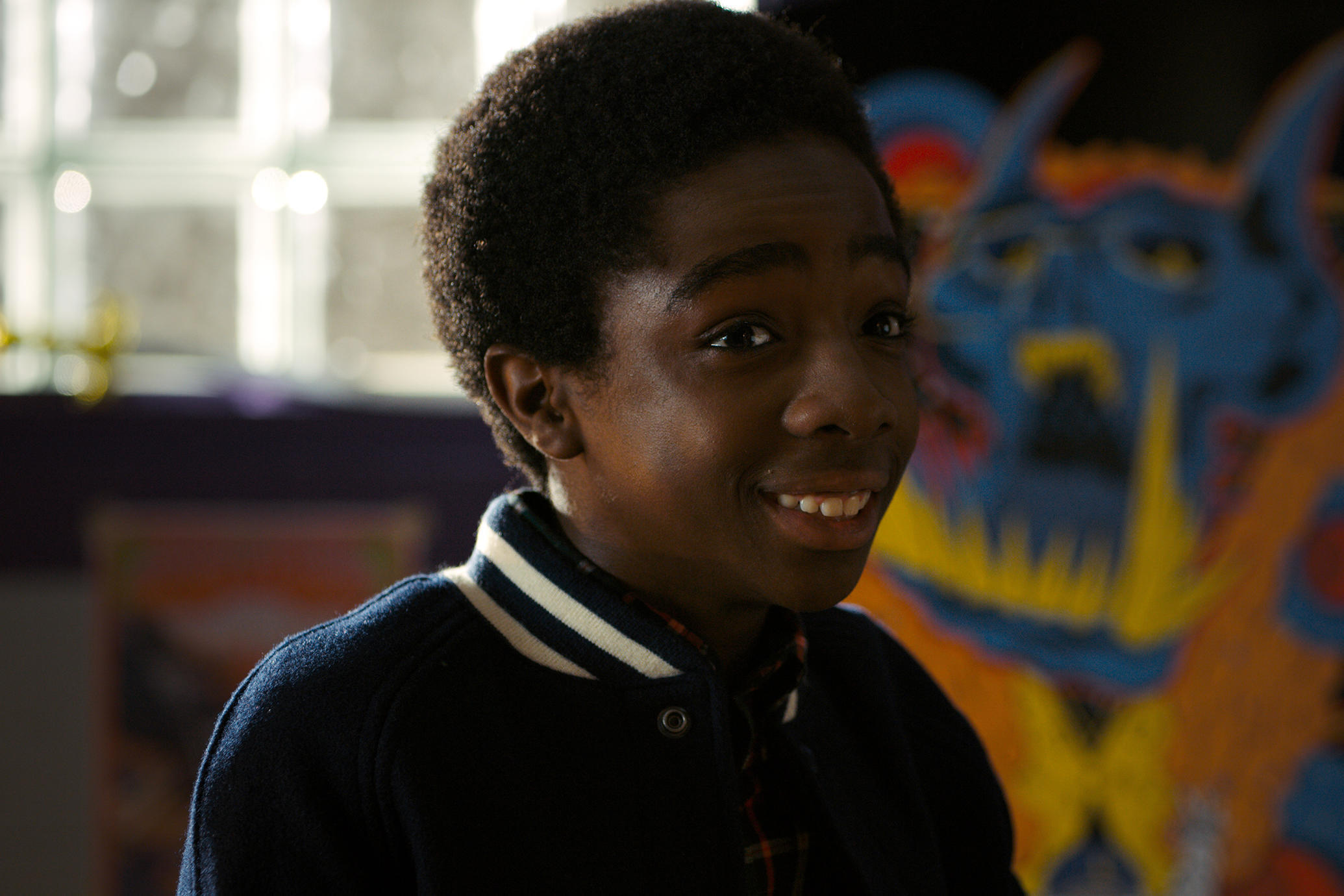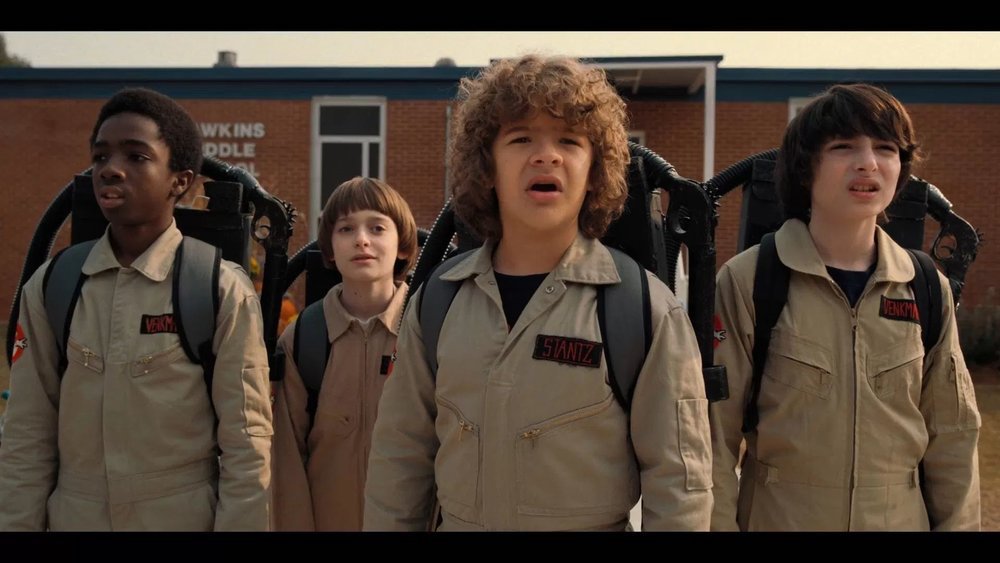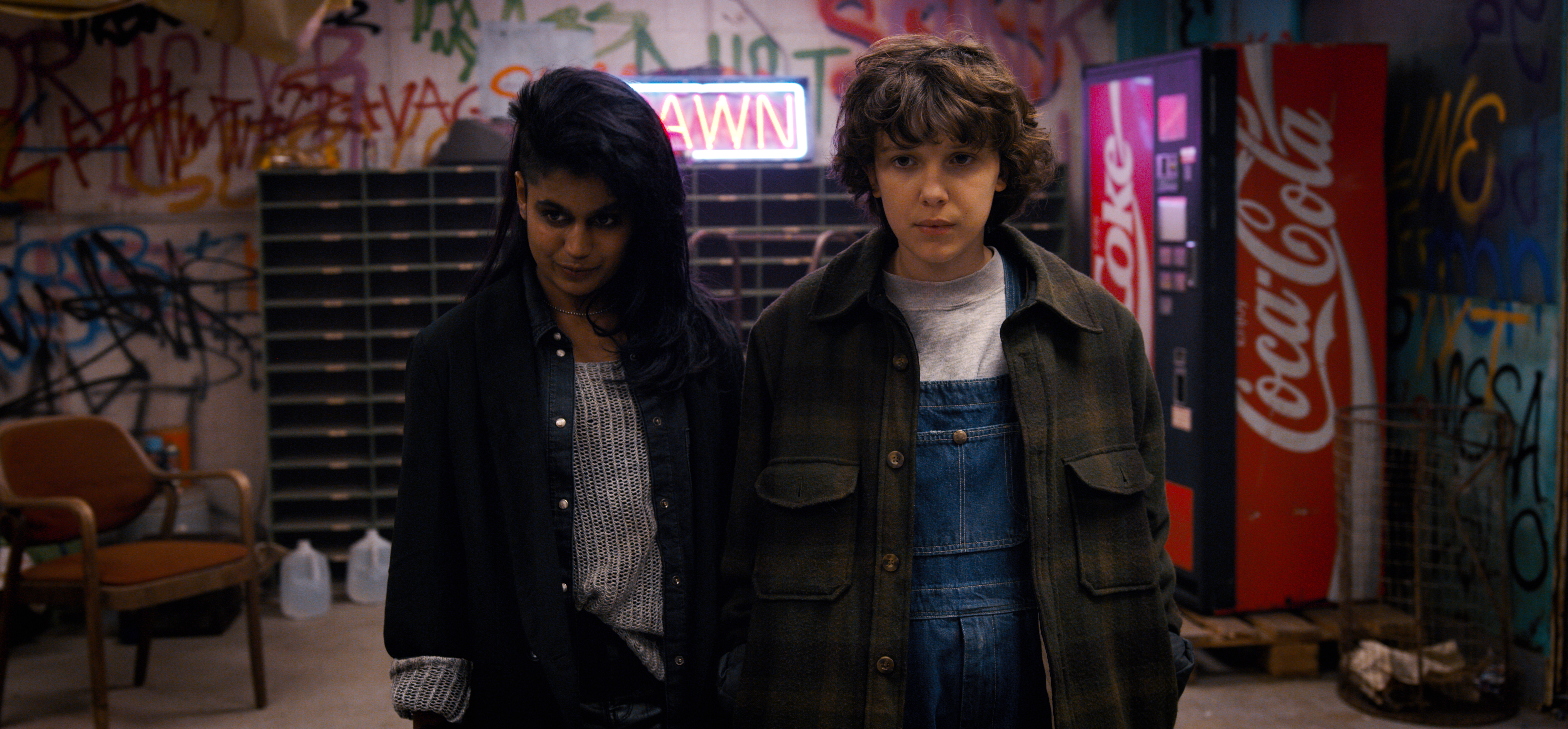Stranger Things and Nostalgia Now
My relationship to Stranger Things is ambivalent. As a child of the 1980s, I remember the analog technologies and cultural objects that the show obsessively brings back to life. Now I'm old enough to appreciate the dexterity of the show's nostalgic layering of mnemonic reference upon mnemonic reference. Those memories can't be separated from the fact that I grew up as a person of color in a largely white, semi-rural town in upstate New York. This personal history means that I identify — or am intended to — with the character Lucas, who belongs to the only black family portrayed in the fictional midwestern town of Hawkins, Indiana. But identification involves, for me, discomfort in this case: discomfort with a nostalgia in which race and ethnicity are treated all too cannily.
My ambivalence turns on how, despite nods to racial diversity and inclusion, the nostalgia of the show is a white nostalgia, politically liberal and economically neoliberal. It is liberal in that the series is nostalgic for a white community that was diverse and multiracial, part of a multicultural project with which the sympathies of Stranger Things almost fully lie. It is neoliberal in that these sympathies are about giving people of color a position within the marketplace, and it provides an understanding of race, ethnicity, and identity as a part of the marketplace. Diversity and inclusion are neoliberal as much as liberal values. Diversity and inclusion are good, from the perspective of neoliberalism, so long as they advance capitalist property and wage relations or at least don't get in the way of the normal workings of the market. Stranger Things cleaves to whiteness and social normativity — and even when it engages racial diversity explicitly, it excludes the real disruptions that solidarity across racial lines might bring to the liberal community and the neoliberal market. This desire to retreat from the social and political conditions of the present and future — the possibility of rupture — is manifest in the nostalgia of the show, its desire, to use the idiom of Joel and Jason's introduction to this cluster, for an '80s phenomenology rather than the 1980s as they were. That this desire is embedded in white nostalgia is nowhere more evident than in the character of Kali, who mobilizes an anti-state, anti-patriarchal, and anti-racist form of solidarity that the nostalgia of Stranger Things can't handle.
But first, Lucas. He is the prime example of how white nostalgia is liberal nostalgia on Stranger Things, even when the show attempts to be critical of liberal racism. The token appearance of Lucas, the lone black friend of the otherwise white group, is a reference to 1980s classics such as The Goonies (Richard Donner, 1985). Lucas replaces Data, the Asian character from The Goonies, with a black character, but one who serves a similar purpose, unintentionally highlighting a certain display of whiteness and white culture that is often hidden in plain sight.

As if to course-correct from the tokenism of Lucas in Season One, Season Two goes out of its way to flesh out his character and even address his race in a self-aware scene from "Trick or Treat, Freak." Here, the four boys dress as the Ghostbusters for Halloween. Playing with racial assumptions, Lucas and Mike both appear in a uniform displaying the name "Venkman." A short discussion follows in which it becomes clear that Mike assumed that Lucas would come dressed as "Winston Zeddmore" because Lucas, like Winston, is black. After listening to Mike's protestations that there cannot be two Venkmans in the group, Lucas points out that he never agreed to be Winston. "No one wants to be Winston, man."1 The boys consider Winston least desirable because he is the only member of the team without a background in science. Lucas suggests that Mike could be the Winston of the group. Mike responds with a stuttered response, saying that he can't be Winston before trailing off. The breakdown in Mike's speech comes with the dawning realization of his own racial assumptions: that Lucas would obviously dress as Winston because he's black, a notion that is given voice by Lucas himself, who says aloud what is otherwise unspoken.

The scene is uncomfortable on several levels. Zeddmore is the least prominent and token member of the Ghostbusters, a status mirrored in Lucas' status as the only person of color in the main cast of Stranger Things.2 The scene illustrates dynamics that are all too often found within liberal racism, in which racist assumptions go unspoken and remain largely invisible among whites, until these assumptions are made visible through contrast or confrontation with people of color.3
This scene is surprisingly self-aware, seeming to acknowledge Lucas' marginalization in the previous season. To its credit, the series attempts to redress its earlier, passive racism. Because it is invisible and everywhere in mainstream media, whiteness works as a default category, just as Lucas would obviously play Winston because they are both black. To see how deep these qualities of whiteness go, consider the recent uproar at the possibility that a popular fictional character, such as James Bond, Batman, or Spider Man, might be reimagined as a person of color.4
Despite its canniness, or because of it, the Ghostbusters scene illuminates a strain of liberal racism running through the show. The inclusion of Lucas, first as a token, then more fully, serves as a weak gesture towards diversity. The show's acknowledgment of its mistake is a familiar gesture, rooted in sympathy that does little to change the conditions through which people of color are othered. Lucas is given more screen time and a more three-dimensional character, but whereas Lucas is given more attention, the show remains markedly white. The acknowledgement is a move that builds sympathy but does little to address the structural conditions through which the show represents race. Lucas' more robust role in the second season provides an alibi for the show's engagement with diversity. His more fulsome inclusion becomes a way of marketing Stranger Things as "diverse" and revealing its own awareness of this gesture towards diversity, allowing the audience to take a certain pleasure in the show's white nostalgia, with its built-in liberal and neoliberal constraints when it comes to nostalgia, race, and ethnicity.
Nostalgia for whiteness is commonly attributed to right-wing politics, but what Lucas' role in Stranger Things shows us is that such nostalgia is liberal, too. The show is branded as liberal, retroactively imagining contemporary values (i.e. neoliberal values) in the context of the past. The nostalgic representation of the 1980s in Stranger Things is camouflage, cloaking the present in the past. Nostalgia always tells us more about the present than the past that it purports to represent. The '80s is at the heart of Stranger Things' branding strategy and the ways that it represents race and ethnicity is a part of the branding as well. Elsewhere, I've written about how race is reimagined under neoliberalism as a kind of "boutique ethnicity," which casts racial identity and ethnic history as commodities that circulate within neoliberal economies of the self.5 I understand neoliberalism, after Wendy Brown, as "a peculiar form of reason that configures all aspects of existence in economic terms." It reimagines everything as subject to the rules and imperatives of the market.6 Brown suggests that we think of neoliberalism as "more termitelike than lionlike," meaning that it works by "boring in capillary fashion into the trunks and branches of workplaces, schools, public agencies, social and political discourse, and above all, the subject."7 Neoliberalism reimagines the individual as a set of attributes — race, gender, and life experiences included — that are treated like a portfolio of assets that need managing.
If Lucas reveals the show's white nostalgia and liberal racism, the show's only other major character of color — Eleven's "lost sister," Kali — reveals its neoliberalism. The first shots of Season Two introduce Kali, a South Asian character who, like Eleven, was subjected to sinister experimentation by the government and, also like Eleven, possesses remarkable abilities to make people see (or not) whatever she wishes. Kali is accompanied by a band of punks, by far the most diverse group in the show, who have each been traumatized and discarded by society and were rescued by Kali. That she is named Kali, after the Hindu goddess of creation and destruction, is a little on the nose and suggests a shallow engagement with non-Western cultures and a fetishistic relationship to ethnicity. Race, here, is rooted in style not history.

Kali is the Magneto to Eleven's Charles Xavier, using her powers to wage a campaign of revenge against the government agency that kidnapped and experimented on her.8 Her vengeance is carried out with lethal force. Kali's self-identification as an outcast is mirrored in her style, shown off in her punk and new wave aesthetic. The show portrays this band of misfits as a clichéd, clumsy amalgamation of counter-cultural ideas. They flaunt social norms not just aesthetically, but politically as well: Kali lives on the margins of society, squatting in a warehouse and stealing to survive. In one telling scene, the band robs a convenience store and is confronted at gunpoint by the store clerk. Kali says that his fight isn't with them but with the "war-criminal billionaires" that own the business that he works for.9 In the end, her argument is unconvincing to the clerk who describes the group as "freaks" before the band incapacitates him. Lest we miss the message that Kali's violence signifies excess, the non-diegetic music playing throughout the introductory montage is "Dead End Justice" by The Runaways.
Kali's militancy is rooted in anger and critique. She understands her violence as justice for the violence perpetrated against her; and the violence carried out against her mirrors the violence of capitalist exploitation at a global level. In Kali, racial difference and social critique are collapsed into a single character whose anger at a system that has genuinely disenfranchised her is framed as excessive and dangerous. Kali's critical stance is portrayed as cartoonishly misguided — it is suggested that she has given in to the "dark side" of her emotions — and yet her critique of society is valid. Though framed as excessive, Kali's violence is the product of the dominant social order: the culture that Kali rejects is the one that white nostalgia longs for. Kali's character is the only one that gives voice to any real social critique — she criticizes the relations of family and community, not to mention property and commodity — and because of this she is cast as a villain, albeit a sympathetic one. Her voice powerfully contrasts with the values otherwise evinced by the show.

The episode in which Eleven meets Kali reveals white nostalgia and normativity working in concert. By the end of the episode, Eleven is forced to choose between Kali and her friends back home; it is a moment in which Kali's anti-social politics is placed against the warmth and sentiment of town and community, where Eggo waffles come to mean all the comforts of home, and which is valorized as the highest motivation for Eleven in the series. Even though Eleven and Kali first greet each other as sisters, a familial bond borne out of their solidarity from the shared experience of being in the lab together, nostalgia, here, works as a palliative or counter-measure, and Eleven leaves her cosmopolitan sister, choosing community over solidarity and the security of reinforced whiteness and middle-class values over the deliberate rejection of societal expectations and solidarity with a disenfranchised woman of color.
Eleven's return to her friends shifts the show from systemic politics and economics back to personal and ethnic tropes in which the call for diversity transitions from demand to brand. An emphasis on anti-discrimination, diversity, and inclusion are widely accepted under neoliberalism but this very acceptance suggests that calls for inclusion are no longer able to mount a real resistance to the forces that engage in widespread economic exploitation. Multiculturalism is in line with neoliberalism insofar as it makes it not just possible but necessary for everyone, regardless of race or ethnic background, to participate in market relations. Racial difference is emphasized and included as a sign of the system's good intensions, despite the fact that racial difference was developed and used for the creation and maintenance of systemic inequalities. This neoliberal maneuver is employed by the show. Kali's violent opposition to participating in normative social relations is effectively contained and countered by the show's emphasis on personal relationships, home, and family over political solidarity — and the market motors on.
White nostalgia longs for a liberal community underwritten by a neoliberal vision of race and ethnicity rooted in the market: what I call boutique ethnicity. In contrast, Kali represents an intolerable alternative to that vision of the normative pastoral. Hers is a violent solidarity that undermines white nostalgia. If Lucas comes to stand for a safely integrationist politics, Kali stands for the violent outcast. Kali's violent and punk sensibilities show us how Stranger Things imagines a set of values genuinely different from its own, which it must contain and reject.
What I find disappointing about Lucas and Kali is that they represent a false binary between community and solidarity. And yet to say, as Stranger Things seems to suggest, that the values of community and solidarity are at odds with one another is to fall into a trap. Community and solidarity are only opposing values when the former is parasitized by a strain of neoliberal thinking, cloaked in nostalgia, that imagines white, bourgeois values as the ground from which all other social goods can grow.
I want to like Stranger Things. I feel the nostalgic pull of the show. But I can't help feeling that, embedded in the show's relatable pleasures, is a palliative politics. Though Lucas is the character that I am meant to identify with, I prefer to side with Kali. She stands for everything that the show wants to reject. She offers a genuine alternative to white nostalgia. I stand with her.
David Bering-Porter is Assistant Professor of Culture and Media at the Eugene Lang College of the Liberal Arts at The New School. His work on film studies, digital media and culture, and race and technology have appeared in Flow, MIRAJ and Los Angeles Review of Books.
References
- Stranger Things 2, "Chapter Two: Trick or Treat, Freak." Directed by Matt and Ross Duffer. Written by Matt and Ross Duffer. Netflix, October 27, 2017.[⤒]
- I'd like to thank Jason Middleton for pointing out this structural connection.[⤒]
- Richard Dyer argues that white supremacy on the left relies on invisibility and obviousness. He argues that whiteness elides itself and becomes invisible as the cultural background against which other racial formations are seen, understood, and measured. Richard Dyer, White: Twentieth Anniversary Edition (New York: Routledge, 2017), 1.[⤒]
- See, for example, Gabrielle Bruney, "Idris Elba was 'Disheartened' by the Backlash Against a Black James Bond," Esquire, June 28, 2019.[⤒]
- David Bering-Porter, "Boutique Ethnicity: On African Ancestry and neoliberal economies of the self" in The Postcolonial World, ed. Jyotsna G. Singh and David D. Kim (New York: Routledge, 2017). [⤒]
- Wendy Brown, Undoing the Demos: Neoliberalism's Stealth Revolution (New York: Zone Books, 2015), 17.[⤒]
- Ibid., 36.[⤒]
- The reference to the X-Men here is especially interesting because Magneto and Charles Xavier are often interpreted as fictionalized versions of Malcolm X's militant stance against anti-racism versus Martin Luther King's pacifist and integrationist stance towards the intense racism the United States.[⤒]
- Stranger Things 2, "Chapter Seven: The Lost Sister." Directed by Rebecca Thomas. Written by Matt and Ross Duffer. Netflix, October 27, 2017.[⤒]
